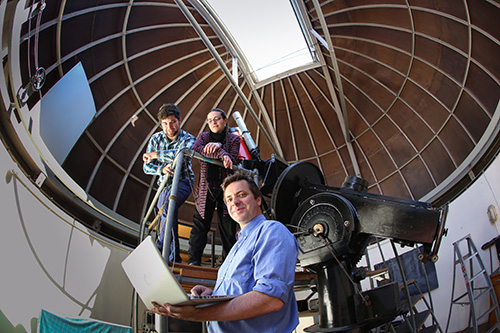Doorway to the sun and stars

Dr Paddy Mcgee with students, Alex kyriacou and Rebecca Blackwell
The observatory at the University of Adelaide is part of the old astronomy building. While many think it stands noble, but idle, the reality is that it places a valuable role in teaching and research at the School of Chemistry and Physics. n teaching, the observatory is predominantly used by students enrolled in the Bachelor of Science (Space Science and Astrophysics.) First-year students undertake introductory practicals in solar and deep-sky imaging in the dome, while those in second year can utilise the observatory to collect data for their research projects. "All of the students do something in the observatory at some stage of their learning," said Dr Paddy Mcgee from the School of Chemistry and Physics. "It's a fantastic resource to have on site in terms of developing hands-on skills in astronomical observation." The observatory is also used in research conducted by the school's High Energy Astrophysics group for collaborative, international observing campaigns. "Areas of study include variable stars and exoplanets," said Dr Mcgee. "We have also conducted monitoring of targets in support of larger facilities such as the HESS gamma-ray telescopes in Africa. If we see a target in outburst, we can advise them to take a look later that day when night falls in Africa". While Dr. Mcgee acknowledged that the location of the observatory, in the middle of town, would not ordinarily be considered ideal, he said this does not prevent obtaining good-quality data. "Attaching modern detectors to the telescope really opens up the opportunity to do high-grade research in such an urban environment," he explained. With a lineage extending back to Charles Todd, a former government Astronomer, the observatory has a long history. It has been used in teaching for some 40 years or more. The observatory is an important and iconic on-campus resource that continues to deliver benefits to students and researchers alike.
|





